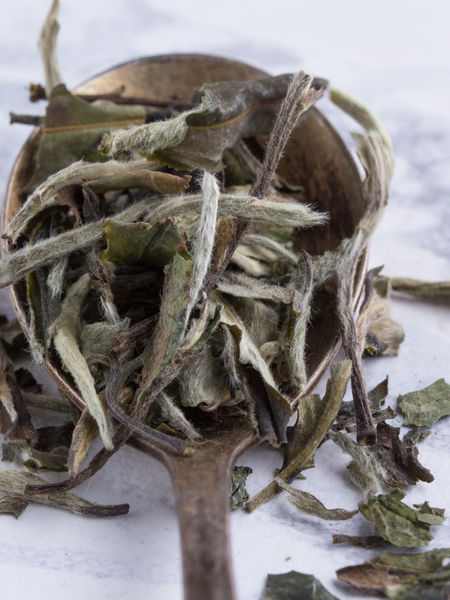ALL ABOUT WHITE TEA


Ephemeral, exquisite, delicate.
White teas are all that, and enchanting, too. Referred to as senior tea in mainland China, it is the preferred drink of many elderly who frequently drink it in a clear glass, the better to watch the elegant sage-colored leaves dance as they offer their flavor.
White teas in various shapes, called mudan, are another entertaining way to serve white tea. Place the mudan in clear goblets, fill with hot water, and you and your guests can watch it “open” or blossom as you dine. You can drink its lovely nectar noted for its melon essence and floral fragrance.
WHERE IT IS GROWNWhite teas have been grown and processed in the southeastern coastal Chinese province of Fujian for nearly a thousand years, but perfected during the last two centuries. While white teas can and are made from Darjeelings and Assams, the signature delicacy of Chinese-grown white teas is not replicated because of terroir, altitude, and other elements of weather and location. “True” white teas are from Fujian where a downy appearance is noticeable on each leaf bud, ya cha (budding leaf,) and on the bottom of each ye cha (fully opened leaf.)
HOW IT IS PROCESSEDChinese white teas can contain the big leaf (da ye) which originated as wild teas (cai cha) in the early 19th century of the Qing Dynasty, particularly in the northeast area of the province in Zheng He and Fu Ding regions. Plucked in the spring, between March 15-April 10 but never while raining, the leaves receive the season’s sunlight which the Chinese believe gives enhanced life-giving essence (qi) to the leaves.
The finest quality white teas are leaf buds only: long, pale green, and delicately aromatic. The leaf buds are withered in bamboo baskets in one of two ways: indoors or in indirect sunlight indoors or out. Indoors they are allowed to air dry to reduce the moisture content by 80% then finished by stacking the baskets over a charcoal fire to eliminate most of the remaining of moisture. Or, the baskets are set out in indirect sunlight and then finished in direct sunlight outdoors until dried. Modern factories use convection ovens to finish the drying and have all but eliminated air drying because it is so time consuming, however, connoisseurs believe the combination of air and sunlight produces better flavor. Some modern processors dry the leaves in woks, enabling the workers to circulate the leaves continuously to ensure evenly dried leaves. It can take seven to eight kilograms of plucked leaf buds to produce one finished kilogram of tea, so intensive labor, much time, and careful production contribute to the price of the finest teas.
TYPES
Silver Needle (Yin Zhen) is a very fine white tea also made exclusively of leaf buds which is, ironically, rather high in caffeine despite its light liquor and color of the buds. It is frequently served in tall clear glasses the better to see the leaf buds ‘dance’ as they infuse the water.
Silver Needle (Yin Zhen) with Jasmine: A classically scented tea, made with elegant tea leaf buds with the fragrance of night-blooming jasmine flowers. This is an ideal stand-alone tea to be savored for both its exquisite full-mouth feel and lingering aftertaste and, of course, the fragrance and taste of sweet jasmine. Whites also blend well with other fruits, flowers, and other flavors, making it an interesting alternative to flavored and scented black teas.
White Peony (Bai Mudan or Bai Mutan): In the finest offerings, each bai mudan contains one leaf bud, complete with downy hairs, and two leaves whose tops are dark green and whose bottoms are replete with downy hairs—quite a challenge! This genuine white peony is referred to as the flower of wealth by the Chinese, or more often, as the king of flowers.
Shou Mei/Gong Mei: Lower priced versions of bai mudans, which should more correctly be called longevity eyebrows or (shou mei) or tribute eyebrows or (gong mei These might also contain stems and a collection of silvery buds, souchong leaves or pekoe leaves. Combined to form a shape that is like the peony flower, it has a fruity autumnal taste, more nutty and woody than Silver Needles, are darker in the cup, and have less complex flavor than a genuine white peony (bai mudan.)
Snowbud (an Adagio favorite): A classic Fujian white with a delicate body and lower caffeine than most, this offering has a clean sweet aroma and texture that is delicate and light from its buds and young leaves plucked in early spring. A very light-tasting tea, one for both the novice white tea drinker and one with an experienced and nuanced palate.
White Darjeeling (an Adagio specialty): From the Rohini estate in Darjeeling, India, this is both a novelty in the world of tea and a superb treat for anyone looking for something unusual and tasty. Made of young leaves and delicate, unopened buds from an early spring plucking, the dry leaves blossom into a fruity liquor redolent of honeysuckle and apricot.
HOW TO BREW:The most important element in brewing white tea best is to brew at low temperatures and for short times. Follow the vendor’s directions or use water temperature heated up to 180 degrees F. and brew at one-minute increments, to taste. For fullest flavor, 3 to 5 minutes should be perfect. You can always brew longer! High-quality white teas offer several infusions.
